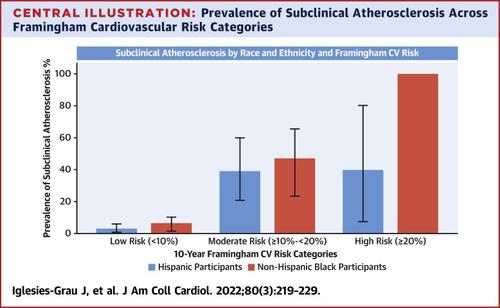Journal of the American College of Cardiology ( IF 21.7 ) Pub Date : 2022-07-11 , DOI: 10.1016/j.jacc.2022.04.054 Josep Iglesies-Grau 1 , Rodrigo Fernandez-Jimenez 2 , Raquel Diaz-Munoz 3 , Risa Jaslow 4 , Amaya de Cos-Gandoy 5 , Gloria Santos-Beneit 6 , Christopher A Hill 4 , Alexandra Turco 4 , Daniella Kadian-Dodov 4 , Jason C Kovacic 7 , Zahi A Fayad 8 , Valentin Fuster 9

|
Background
Non-Hispanic Black persons are at greater risk of cardiovascular (CV) events than other racial/ethnic groups; however, their differential vulnerability to early subclinical atherosclerosis is poorly understood.
Objectives
This work aims to study the impact of race/ethnicity on early subclinical atherosclerosis in young socioeconomically disadvantaged adults.
Methods
Bilateral carotid and femoral 3-dimensional vascular ultrasound examinations were performed on 436 adults (parents/caregivers and staff) with a mean age of 38.0 ± 11.1 years, 82.3% female, 66% self-reported as Hispanic, 34% self-reported as non-Hispanic Black, and no history of CV disease recruited in the FAMILIA (Family-Based Approach in a Minority Community Integrating Systems-Biology for Promotion of Health) trial from 15 Head Start preschools in Harlem (neighborhood in New York, New York, USA). The 10-year Framingham CV risk score was calculated, and the relationship between race/ethnicity and the presence and extent of subclinical atherosclerosis was analyzed with multivariable logistic and linear regression models.
Results
The mean 10-year Framingham CV risk was 4.0%, with no differences by racial/ethnic category. The overall prevalence of subclinical atherosclerosis was significantly higher in the non-Hispanic Black (12.9%) than in the Hispanic subpopulation (6.6%). After adjusting for 10-year Framingham CV risk score, body mass index, fruit and vegetable consumption, physical activity, and employment status, non-Hispanic Black individuals were more likely than Hispanic individuals to have subclinical atherosclerosis (OR: 3.45; 95% CI: 1.44-8.29; P = 0.006) and multiterritorial disease (P = 0.026).
Conclusions
After adjustment for classic CV risk, lifestyle, and socioeconomic factors, non-Hispanic Black younger adults seem more vulnerable to early subclinical atherosclerosis than their Hispanic peers, suggesting that the existence of emerging or undiscovered CV factors underlying the residual excess risk (Family-Based Approach in a Minority Community Integrating Systems-Biology for Promotion of Health [FAMILIA (Project 2)]; NCT02481401)
中文翻译:

年轻、社会经济弱势的西班牙裔和非西班牙裔黑人成年人的亚临床动脉粥样硬化
背景
与其他种族/族裔群体相比,非西班牙裔黑人患心血管 (CV) 事件的风险更大;然而,人们对它们对早期亚临床动脉粥样硬化的不同脆弱性知之甚少。
目标
这项工作旨在研究种族/民族对社会经济弱势青年早期亚临床动脉粥样硬化的影响。
方法
对平均年龄为 38.0 ± 11.1 岁的 436 名成人(父母/看护人和工作人员)进行了双侧颈动脉和股骨 3 维血管超声检查,其中 82.3% 为女性,66% 自我报告为西班牙裔,34% 自我报告为西班牙裔非西班牙裔黑人,并且在 FAMILIA(少数民族社区中以家庭为基础的方法整合系统-生物学以促进健康)试验中招募了来自哈林区(纽约州纽约市附近)的 15 所启蒙幼儿园的 CV 病史美国)。计算了 10 年 Framingham CV 风险评分,并使用多变量逻辑和线性回归模型分析了种族/民族与亚临床动脉粥样硬化的存在和程度之间的关系。
结果
平均 10 年 Framingham CV 风险为 4.0%,种族/民族类别没有差异。亚临床动脉粥样硬化的总体患病率在非西班牙裔黑人 (12.9%) 中显着高于西班牙裔亚群 (6.6%)。调整 10 年 Framingham CV 风险评分、体重指数、水果和蔬菜消费、身体活动和就业状况后,非西班牙裔黑人个体比西班牙裔个体更可能患有亚临床动脉粥样硬化(OR:3.45;95% CI : 1.44-8.29;P = 0.006) 和多地域疾病 ( P = 0.026)。
结论
在调整了典型的 CV 风险、生活方式和社会经济因素后,非西班牙裔黑人年轻人似乎比他们的西班牙裔同龄人更容易患早期亚临床动脉粥样硬化,这表明存在新出现或未发现的 CV 因素导致剩余超额风险(基于家庭的少数民族社区整合系统生物学促进健康的方法 [FAMILIA(项目 2)];NCT02481401)











































 京公网安备 11010802027423号
京公网安备 11010802027423号